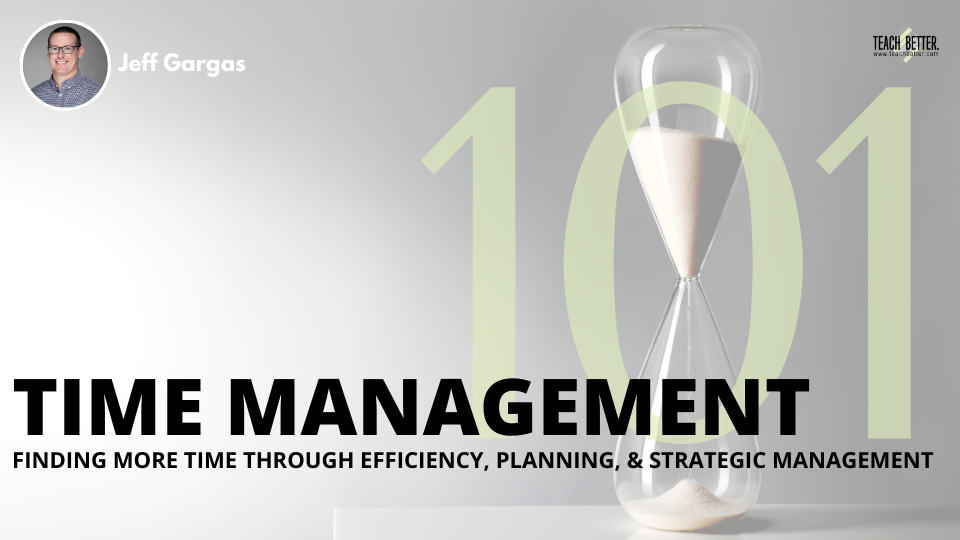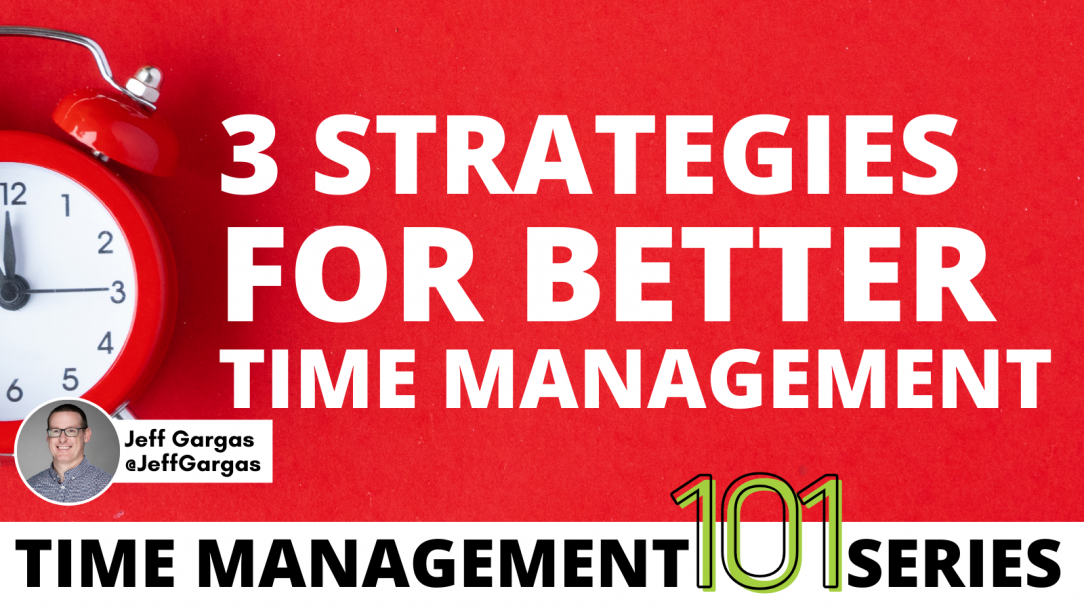TL;DR:
- Time management strategies include tracking then analyzing your usage, using calendar blocking, and implementing the Ivy Lee Method.
- Remember that implementing new strategies takes time and you likely won’t be consistent at first. Better time management means efficiency increases. This leads to feeling better, performing better, working better, and more free time.
If you’re like me, your time is limited, valuable, and often feels out of control. Sound familiar? Maybe a little too familiar? It’s okay. Time management is not easy. If it were, there wouldn’t be 5 billion results on Google for blogs, videos, books, courses, and coaches all built around it. (Don’t quote me on that number, but I’m pretty sure 5 billion is accurate.)
So, why do we struggle with time management, and how do we get better at it?
I’m going to start by being very clear on two things:
- I struggle with time management almost daily, so I do not have all the answers, just things that help me.
- I’m only going to cover 3 strategies in this post, so as to not overwhelm either of us.
Why We Struggle with Time Management
Before we get to any strategies or ideas here, we need to understand why we struggle with this. Better understanding what causes our struggle allows us to be better focused on how to be better, which in itself, will improve our efficiency in using our time, which is a huge part of effective time management.
There are a lot of reasons why we struggle with managing our time. In some cases, we’re not effectively or efficiently using the time we have. Other times, we’re not utilizing the people or resources we have to help us. Sometimes it’s just a result of the overwhelm consuming us and making our already limited time feel even more limited. And a lot of times it’s because we’re not focusing our time on the things that actually matter to us.
I think, though, one of the most common reasons we struggle with this is because we have unreal expectations of how productive we should be, how efficient we need to be, and how much better others are at it than we are.
Too often we are comparing ourselves to other people that we THINK have it all figured out. So many of us are chasing after this unrealistic dream of balance or perfection that we have somehow convinced ourselves that everyone else has, even when we actually have no idea of what they do or do not have figured out.
We base these assumptions on what we see from them, which is typically only what they choose to show us or allow us to see. Or worse yet, we don’t even see that they are struggling too, because we’ve been judging ourselves so badly that all we see are the pieces of their lives that seem to be in control and managed.
I need you to hear this.
Someone else’s ability to appear to have it all together does not mean you have it less together than them. More important still, it also does not mean you have to have it together in the same way they do.
So, let’s be very clear here. If you have any delusion that a blog post, a video on YouTube, an ebook, an online course, or even that new Bullet Journal is somehow going to make you manage your time as well as you have convinced yourself that Suzy, Sally, Jim, Joe, or whoever does, STOP. Stop comparing yourself to the illusion of productivity and effectiveness that you have made others out to be in your mind. They’re struggling too. I promise you. Focus on you, your time, and how you can be better. I will admit that things like time management training can work for a lot of people, as I’ve heard, however, it all starts with you and how you can make yourself be better.
(Notice: I said better…not perfect.)
Ok, so full disclosure: I needed you to hear that. But I also had to type it out so I would hear it as well.
Now that we’ve agreed to stop judging ourselves based on the judgments we’ve placed on others without knowing what is real and what is just an Insta-worthy post, let’s take a look at 3 simple strategies for better time management.
Strategy #1: Track your time usage for at least 2 weeks, and analyze it.
One of the most common mistakes I think people make when it comes to time management is thinking they know where all their time goes, or how much time they spend on everything. Yes, you may very well be awesome at always looking at the clock and keeping a mental note of how much time each little task takes.
But are you REALLY mentally keeping track of everything? Do you remember every time you’ve switched tasks or how many times you got a notification and checked that email? Is your mind always focused on that mental list of where all your time went, at all times? And if so, is that really the best use of your mental capacity? The answer is no…for all of those. I don’t care how good you think you are, you’re missing things. You’re missing seconds, which turn into minutes, and then hours.
When you track your time with an app—whether that is on your phone, the web, or a sheet of paper—you’re able to input the task and time. And then you can put your mental energy into completing that task.
More importantly, though, when we intentionally track our time, and not just mentally take note, we are forcing ourselves to think about everything we do throughout the day, every decision we make with our time.
If time is our most valuable currency, tracking it is how we balance our time checkbook. It’s how we make sure we’re not falling victim to the checkout line candy bars (emails, social media, etc). And I assure you, it is one of the best ways to increase your efficiency.
I can already hear you.”Ugh, but then I have to have some app open. And I have to type in what I’m doing, and start and stop it. Ugh, ugh, ugh.”
Trust me, it’ll take you less than 30 seconds once it’s routine. AND, that 30 seconds is INTENTIONAL and PURPOSEFUL. And when we INTENTIONALLY think about it, we are much, much more likely to be aware of what we’re doing.
Think about it like this: If you get to work and immediately check your email, you can blow through 20 minutes (or um…20 hours) in what feels like no time. OR, you jump on Twitter or Instagram and start down a rabbit hole of information, and boom! 30 minutes gone…before you even start your day.
If today, you track that Instagram check-in that turned into an hour of browsing TikTok (because yeah, that happens), TOMORROW you’ll be much more likely to think about it. And before you pick up your phone and jump into that mess, you’ll be more likely to make an intentional decision to spend your time on something more important.
REMEMBER: When you say YES to something (like browsing IG for 15 minutes) you’re saying NO to something else (like knocking off that 15-minute task).
A lot of times we think of this only in terms of “If I say yes to this new opportunity at work, I’m saying no to time with my family.” But even when what we’re saying yes to doesn’t actually require someone asking us about it (or us even saying yes) we’re still saying no to something else. And while that 15 minutes away from a work task is not the same as time away from your family, saying no to that 15 minutes task today might mean you have to say yes to that task tomorrow…when you were supposed to say yes to another task.
So then you have to say no to that other new task (that may actually be a 30-minute task), which then means no to another task the next day in order to say yes to this new task you said no to today. Over and over again, things get bumped and shifted.
And what you’ll find is, at some point, that simple yes you gave to 15 minutes on IG, has compounded to 30 minutes, or 60, or 90, or multiple hours of your time on another day, which leads to you needing to stay later, or work more at home, or put time in on the weekend….forcing you to now say NO to something that is far more important to you than that original, seemingly insignificant, little “yes” you said to 15 minutes on IG.
Ok, now I know that was pretty long-winded and probably confusing to follow, BUT…I’m pretty sure you’ll think about it tomorrow, and maybe…just maybe, you’ll be just a little more intentional with your time.
The point is this, by tracking everything we spend our time on, we force ourselves to be intentional about WHAT we spend our time on.
Tracking your time allows you to look at how you spend it and analyze it to be better. It allows us to measure how our time is spent. Like Chris Drucker says: “If you can’t measure it, you can’t improve it.”
What it really boils down to is this: If you are not willing to religiously track your time for just 2 weeks in order to be better, then you do not really want to be better at managing your time. I mean, it’s two weeks of focus—and maybe some uncomfortableness—for the opportunity to increase your productivity and efficiency forever.
So, how do we effectively track our time for these 2 weeks?
You put every single thing you do down somewhere. I use an app called Toggl. Toggl is a free time tracking app. It has a web version and a pretty nice app. It allows you to set up different projects, which are just categories or labels for where your time goes.
You can then include more detailed notes of the specific tasks within each category or project. You can edit and adjust entries super easily, in case you forget to start or stop your tracker (remember, you won’t be perfect). And you can even manually add entries if needed. It then provides you with reports so you can see how you use your time. I’m not going to lie; I recommend Toggl, always, every time, all day every day, but there are a ton of other options out there.
Anyway, you track everything in it…everything. Making another cup of coffee, taking an unplanned phone call, restroom breaks, social media check-ins, everything. It’s not easy at first, but you’ll get there. Think of it the same way you would track your diet. Everything goes into it, even the 5 M&M’s you snagged walking by the dish on the counter. Track it all.
Once you’ve tracked your time for two weeks, you need to analyze it. Take a look at where your time is going, how much time you spent on distractions, and whether you spent the majority of your time on things that are most important. Look at what you could (or should) take off your plate, where you can delegate, or what is taking up way more time than you thought.
I’ll get into more details on how to use Toggl and how to specifically analyze your results in another couple of posts. For now, let’s get back on track.
Strategy #2: Use calendar blocking.
Calendar blocking is a strategy where you block off specific times in your calendar for specific tasks. You create “blocks” of time that are only to be filled with specific tasks, such as checking emails. So those blocks are then set to specific lengths of time, based on the tasks they are reserved for.
One reason this is effective is that it will change the way you look at your to-do list. When you block off time for tasks, you can change your to-do list from “a million little things I have to do” to “blocks of productive work time.” Something to keep in mind is that you should be looking at your calendar as a list of the minutes and hours in your day. I mean, that’s literally what it is. It is the best app available for creating a visual representation of your time. So, by blocking off specific time for specific tasks, your calendar can become your #1 time management tool.
Calendar blocking also works really well with task batching, which is when you take your calendar blocks and organize similar tasks together to increase efficiency.
For example, if I know I need to write a blog post today, and I need to update something on our website, I can batch those two tasks together because they both require me to log into our site. While it might seem like a minor thing, those few minutes—or seconds even—that I will now save because I only need to log in once will add up.
If you save 30 seconds from batching two tasks, and do that 4 times a day, you’ve saved two minutes that day. Now, that might not seem like much, but it adds up. And besides, we came here today feeling like we had zero extra time to do anything, right? So every minute saved is an extra minute to put toward something we “didn’t have time for” yesterday.
[scroll down to keep reading]
Strategy #3: Implement the Ivy Lee Method.
This is a seemingly simple strategy to put in place, but it is extremely powerful. At the end of every day, before you enter your shut down routine, write down the top 6 priorities for the next day. Order them by priority, while taking into account your calendar blocking, task batching, and potential interruptions. Then, each day, start with those 6 tasks.
Now there is, of course, a chance that these most important tasks can’t always be done first. Or that they can’t be done in the true order of importance. You may need items or answers from other people to complete them, they may only be able to be completed at certain times, etc. The goal here is to have them laid out before your day even starts, organized so you can complete them in order of importance, the best you can.
I like to take this just a little further, and organize my entire task list by order of importance.
I still calendar block and task batch, but with task priorities guiding everything.
Another nice side effect of this is that you’ll start to get a sense of your “average task capacity.” This is the average number of tasks you can check off during a typical day. If you pay attention to this and analyze it often, you can start to shift future tasks and make those long daily to-do list a little more realistic, and less overwhelming.
When you plan realistically and lower the number of tasks on your list each day, you’ll find that your efficiency will increase. Fewer tasks means it is more likely that you’ll check off all or most of them. And when we check off more, we feel better. When we feel better, we perform better. Feeling better, working better, and being realistic all lead to better efficiency, which leads to more freed up time.
Like I said at the start, these are just 3 of the many strategies you can put in place to increase the effectiveness of your time management. The most important thing to remember is that you will most likely implement any or all of these inconsistently at first. And that is okay. Even when you get consistent with them, you’ll overlook one here or there, skip the process from time to time, and still get overwhelmed and off track. That is all okay. Remember, it’s about being better…not perfect.
The best time management tip I’ve learned is to redefine what time gets to be. I used to believe time was limited and that there was only a finite amount of time to get things finished. This led to a mindset of needing to hurry, hustle, and the idea that something would always be left behind or not completed. When I learned to honor time as expansive, and that there is always more than enough of it, the urgency was reduced. A standard I live by is that I always find a way to complete the tasks I have committed to. This means I am always in control of the time that surrounds me. This simple shift of what time can be defined as has increased my productivity and my enjoyment in life that surrounds me each day! – Lindsay Titus, K-12 Behavior Specialist and Educational Coach with DEFINE YOUniversity (@ltitus828)
See the full Time Management 101 blog series here!
About Jeff Gargas
Jeff Gargas is the COO and co-founder of the Teach Better Team, and co-author of the Teach Better book. Prior to co-founding Teach Better Team, Jeff was the owner of ENI Multimedia, an online marketing firm, where he worked with entrepreneurs and small businesses, assisting them with web design, social media, content marketing, and brand awareness.
Prior to all of this, Jeff was an adjunctive professor at Kent State University and spent 10+ years in the music industry. He has spoken at conferences around the country, and has successfully promoted more than 500 events and launched 7 businesses in a variety of industries.
Jeff is passionate about music, and enjoys spending time with his family as often as possible. He is also a member of the Teach Better Speakers Network.




